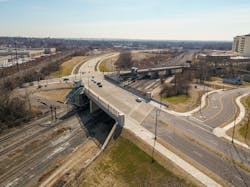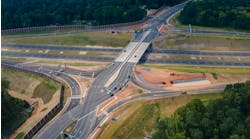The Ohio Department of Transportation (ODOT) wanted to foster transportation access and improve urban neighborhoods. So, the agency studied the idea of creating an “Opportunity Corridor” in 2000. Years later, the concept took shape as a way to improve the roadway system and mobility. and the Opportunity Corridor Project was born.
ODOT accepted the challenge of economic development in the roughly 1,000 acres between I-490 and University Circle in Cleveland. The area was a historically underserved, economically depressed zone. By transforming the 3.5-mile area, the $221 million project would give a boost to the surrounding community.
Earning the communities trust was a hurdle for the project. The “Forgotten Triangle,” as it was called, is one of the poorest areas in Cleveland. The neighborhoods had experienced decades of job loss and population loss, leaving an abundance of abandoned residential, commercial, and industrial properties. Residents were weary of the project, even though they wanted the area cleaned up with new development and job opportunities. Many thought the Opportunity Corridor was going to be a cut through between the freeway system and University Circle, which had originally been proposed in the 1960’s.
ODOT engaged in local stakeholders from the beginning, steering a committee made up of federal, state, regional, county, city, and neighborhood representatives. Many individual and group meetings took place with both residents and businesses, allowing the ODOT and HNTB to better understand each neighborhood’s strength, challenges, and opportunities.
The project focused on the community, creating partnerships and programs to generate new job and career opportunities. Talking with the residents showed that many wanted jobs or job training. In response, the project committed $500,000 to Ohio Means Jobs, a collaborative workforce system that helps local employers meet their talent needs while also helping job seekers find success.
Matt Wahl, senior project manager of the Opportunity Corridor, said the feedback on the project is totally different now. “The public involvement process really helped resolve most of these concerns," he said. "Fast forward through eight years of construction and now that the roadway is open and there are signs of development, you now hear a lot of praise for the roadway, and how convenient it is and how nice it looks. It is actually very heavily used. There has also been praise for the IDE program and the workforce development efforts. Overall, support has evolved to mostly positive, a 180 degrees from the early planning phase.”
To support community engagement, the Opportunity Corridor Environmental Impact Statement (EIS) was developed to better communicate project details and the decision-making process of stakeholders. ODOT realized that the EIS had to be readily understandable to the general public. The EIS were developed in a reader-friendly format, providing technical information in clear ways that could be easily read. The EIS was shared online and in public places, ensuring that it would be easily accessible to the community.
The Opportunity Corridor has improved not only the transportation system in the “Forgotten Triangle”, but it also supports planned economic development in the area. New businesses are coming into the area and old ones are expanding. Residents have begun to see the positive effects of the transition with the new chapter in this area’s history. R&B
Project: Opportunity Corridor
Location: Cleveland, Ohio
Owners: Ohio Department of Transportation
Designer: HNTB Corporation (Preliminary Engineering/NEPA documentation/Section 1 designer/Owners Representative Sections 2 and 3) GPD Associates (Section 2 designer) Michael Baker International (Section 3 designer)
Contractor: Perk/McTech J.V. (Section 1), Great Lakes Construction Company (Section 2), Kokosing Construction Company (Section 3)
Cost: $221 million
Length: 3.5 miles
Completion Date: December 2022



